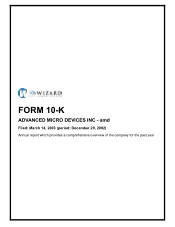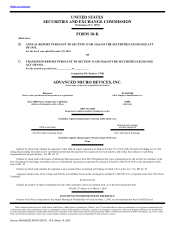AMD 2002 Annual Report Download - page 10
Download and view the complete annual report
Please find page 10 of the 2002 AMD annual report below. You can navigate through the pages in the report by either clicking on the pages listed below, or by using the keyword search tool below to find specific information within the annual report.
Table of Contents
process technologies at a fast pace and offer higher-performance microprocessors in significantly greater volumes. We also must achieve manufacturing yield
and volume goals while producing these higher-performance microprocessors in order to offer these products at competitive prices.
Intel has dominated the market for microprocessors used in PCs for many years. As a result, Intel has been able to control x86 microprocessor and PC
system standards and dictate the type of products the market requires of Intel’s competitors. In addition, the financial strength of Intel allows it to market its
products aggressively, target our customers and our channel partners with special incentives and to discipline customers who do business with us. These
aggressive activities can result in lower limit sales and average selling prices for us and adversely affect our margins and profitability. Intel also exerts substantial
influence over PC manufacturers and their channels of distribution through the “Intel Inside” brand and other marketing programs. As long as Intel remains in
this dominant position, we may be materially and adversely affected by its:
• pricing and allocation strategies and actions;
• product mix and introduction schedules;
• product bundling, marketing and merchandising strategies;
• control over industry standards, PC manufacturers and other PC industry participants, including motherboard, chipset and basic input/output system
(BIOS) suppliers; and
• user brand loyalty.
We expect Intel to maintain its dominant position in the marketplace as well as to continue to invest heavily in research and development, new
manufacturing facilities and other technology companies. Intel has substantially greater financial resources than we do and accordingly expends substantially
greater amounts on research and development than we do.
Intel also dominates the PC system platform. As a result, PC original equipment manufacturers, or OEMs, are highly dependent on Intel, less innovative on
their own and, to a large extent, distributors of Intel technology. In marketing our microprocessors to OEMs, we depend on third-party companies other than Intel
for the design and manufacture of core-logic chipsets, graphics chips, motherboards, BIOS software and other components. In recent years, many of these
third-party designers and manufacturers have lost significant market share to Intel or exited the business. In addition, these companies produce chipsets,
motherboards, BIOS software and other components to support each new generation of Intel’s microprocessors, and Intel has significant leverage over their
business opportunities.
To compete with Intel in the microprocessor market in the future, we intend to continue to form close relationships with third-party designers and
manufacturers of chipsets, motherboards, graphics chips, BIOS software and other components. Similarly, we intend to expand our chipset and system design
capabilities and to offer OEMs licensed system designs incorporating our processors and companion products. We cannot be certain, however, that our efforts
will be successful.
We do not currently plan to develop microprocessors that are bus interface protocol compatible with Intel microprocessors because our patent cross-license
agreement with Intel does not extend to microprocessors that are bus interface protocol compatible with Intel’s sixth and subsequent generation processors. Thus,
our current and future microprocessor products are not designed to function with motherboards and chipsets designed to work with Intel microprocessors. Our
ability to compete with Intel will depend on our ability to ensure that PC platforms are designed to support our microprocessors. A failure of the designers and
producers of motherboards, chipsets and other system components to support our microprocessor offerings would have a material adverse effect on us.
5
Source: ADVANCED MICRO DEVIC, 10-K, March 14, 2003























